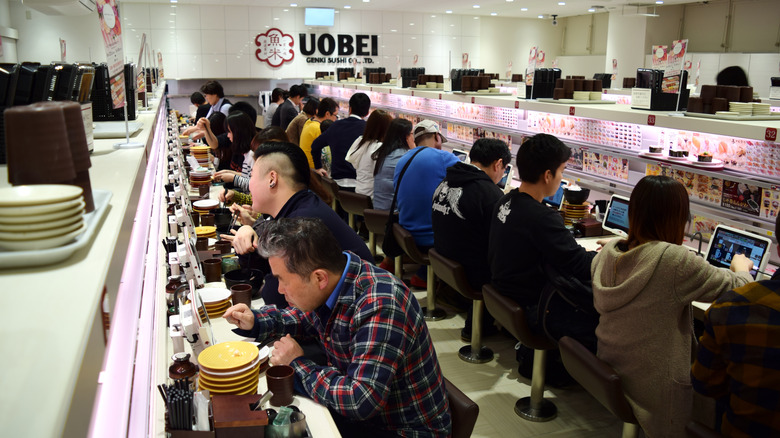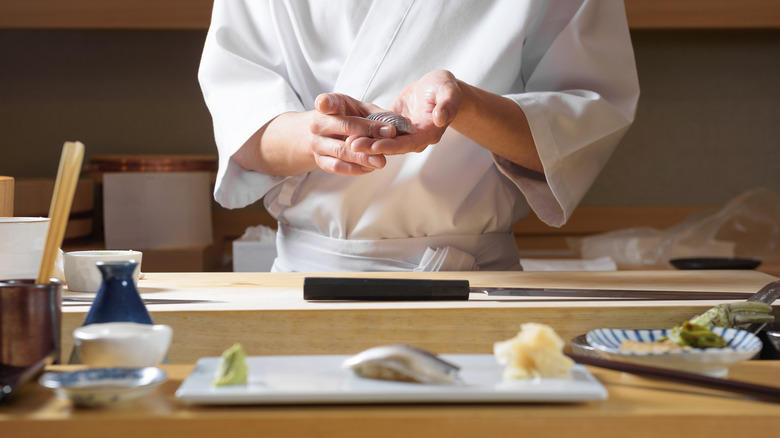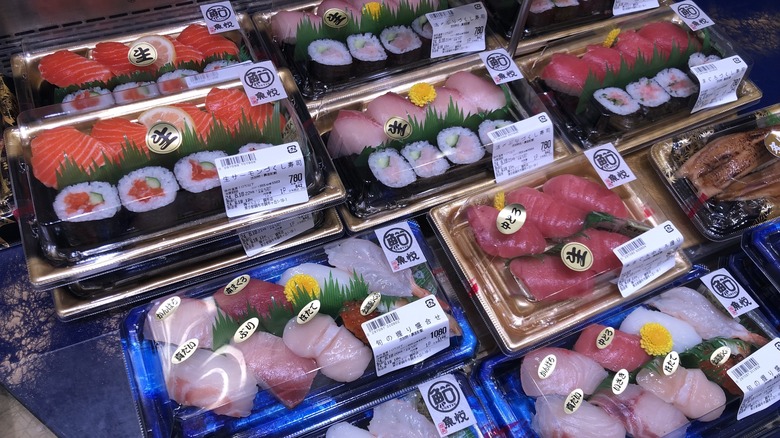The Best Time Of Day To Eat Sushi In Japan For Lower Prices
Tokyo is the city with the most Michelin-starred restaurants in the world, many of which are sushi restaurants. This idea of high-end sushi, with or without stars, differs from what a tourist might get at a sushi-go-round (pictured above) or a fish market in any Japanese port city. At the Tsukiji Outer Market — one of the best things to do in Tokyo for first-time visitors — most of the sushi shops close in the early afternoon. You're more likely to be eating a fresh sushi breakfast or brunch there. Toyosu, where the wholesale Inner Market relocated in 2018, begins its famous tuna auction tours bright and early at 5:45 a.m. Its restaurants end their workday at 3 p.m.
For dinner, you can go high-end, but that kind of sushi doesn't come cheap, and it's not always easy to get a reservation, either. Certain upscale restaurants in Ginza, Tokyo, like the world-renowned Sukiyabashi Jiro or even the two-star Sushi Kanesaka, only accept reservations from overseas customers through a hotel concierge. There's not much difference in price between lunch and dinner at the three-star Harutaka; both will set you back hundreds of dollars.
Maybe this is why, contrary to popular belief, sushi isn't necessarily an everyday food for most Japanese people. It's more the type of meal you would have on a special occasion. Fortunately, if you dine on it at the right time of day, you can get a better deal on sushi during your own special travel occasion in Japan.
Do a lunch course for omakase sushi
A hallmark of high-end sushi is the omakase (or chef's choice) course, where you eat what you're served, barring any allergies. Though some restaurants spend all day preparing to serve these courses at dinner only, others have a lunch option, and it's often more affordable. One such restaurant recommended by Eater is Sushi Ginza Onodera. This is a good example of a high-end restaurant with a significant price difference between the seasonal omakase course for lunch and dinner. As of this writing, it's 27,500 yen (about $174) for the dinner course, whereas it's only 16,500 yen (about $105) for the lunch course.
That's still not cheap, but it saves you almost $70, and you can sample top-notch Edomae sushi from the same restaurant. At the one-star Udatsu Sushi, you could save a hundred dollars between the cheapest lunch and dinner course. These are just examples, and it goes without saying that "high-end" isn't the be-all, end-all of sushi.
You can also find some mid-range omakase courses at places like Sushi Azabu. Located in the Azabudai Hills complex, this restaurant will put you near one of the world's most popular museums. Its 4,800-yen (around $30) lunch course is flagged as "light omakase," and there's no mention of it being "delivered directly from Toyosu" like the 9,800-yen ($62) dinner course. Yet you're saving 5,000 yen (over $30) just by doing lunch instead of dinner. When all else fails, budget-wise, there's always the faithful sushi go-round.
Do kaitenzushi or sushi bentos outside the rush or in the evening
For budget travelers who want a more filling sit-down meal, the best time to dine at a sushi-go-round (in Japanese, "kaitenzushi") is outside the lunch or dinner rush. These conveyor-belt restaurants are cheap all day, letting you grab from revolving plates priced as low as 110 yen ($0.69) for two pieces. At chains like Uobei and Kura Sushi, you can add to your pile through a touch panel, which soon rockets plates to your booth or counter seat. During the rush, however, you could find yourself waiting to be seated behind families and waiting longer for your order to arrive. That should be less of a problem right at opening time or in the mid-afternoon.
Some supermarkets sell ready-made, bento-box sushi that's decent by Japanese standards and arguably better than what you'd find in an American chain like Publix, where the "seaside combo" consists of generic salmon and tuna maki. The quality can vary even within the same supermarket. At Maruetsu, for instance, the Uoetsu-branded sushi in the seafood section usually looks fresher and more appetizing than the rolls in the delicatessen.
Go early in the day unless you want sushi that's been sitting out longer and is nearing its expiration hour. On the other hand, supermarkets and department store food basements usually do a markdown on unsold bentos before closing time. If you're not picky, you can probably nab some discount sushi in the evening.


